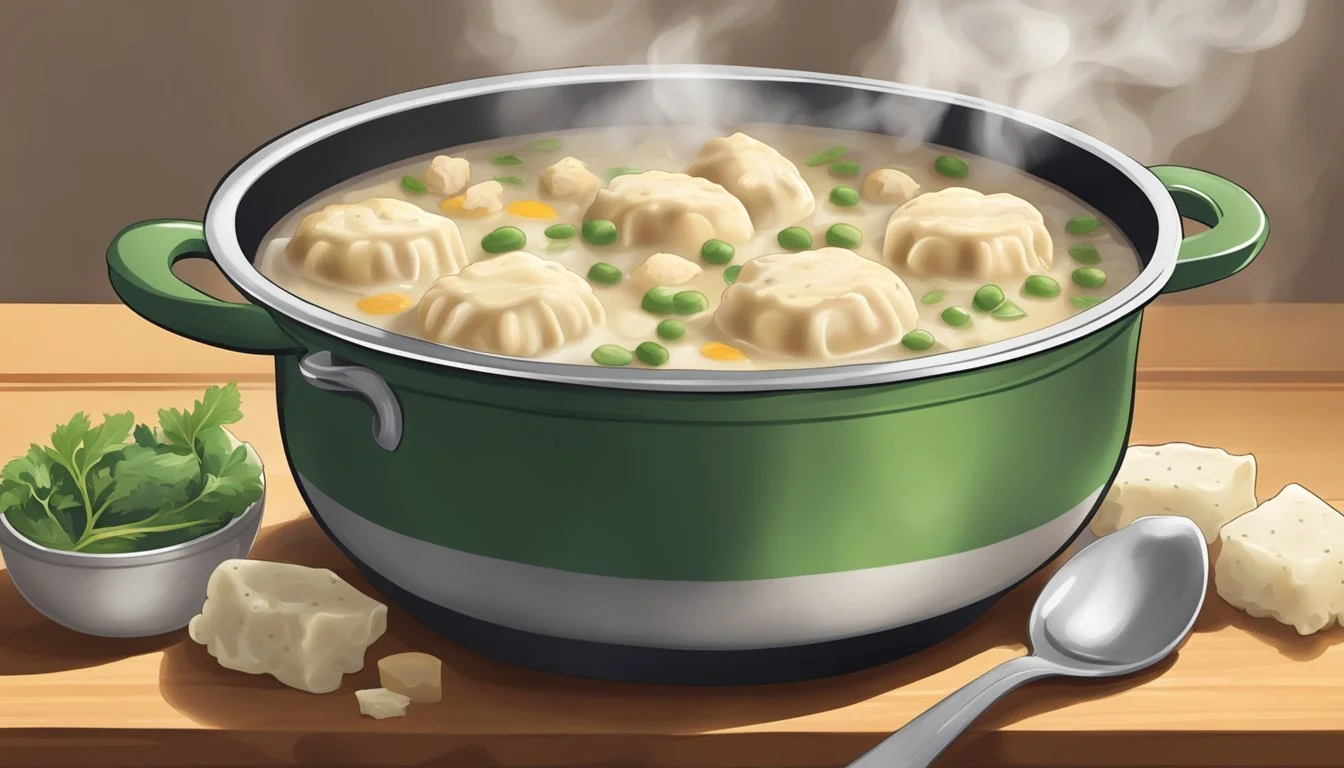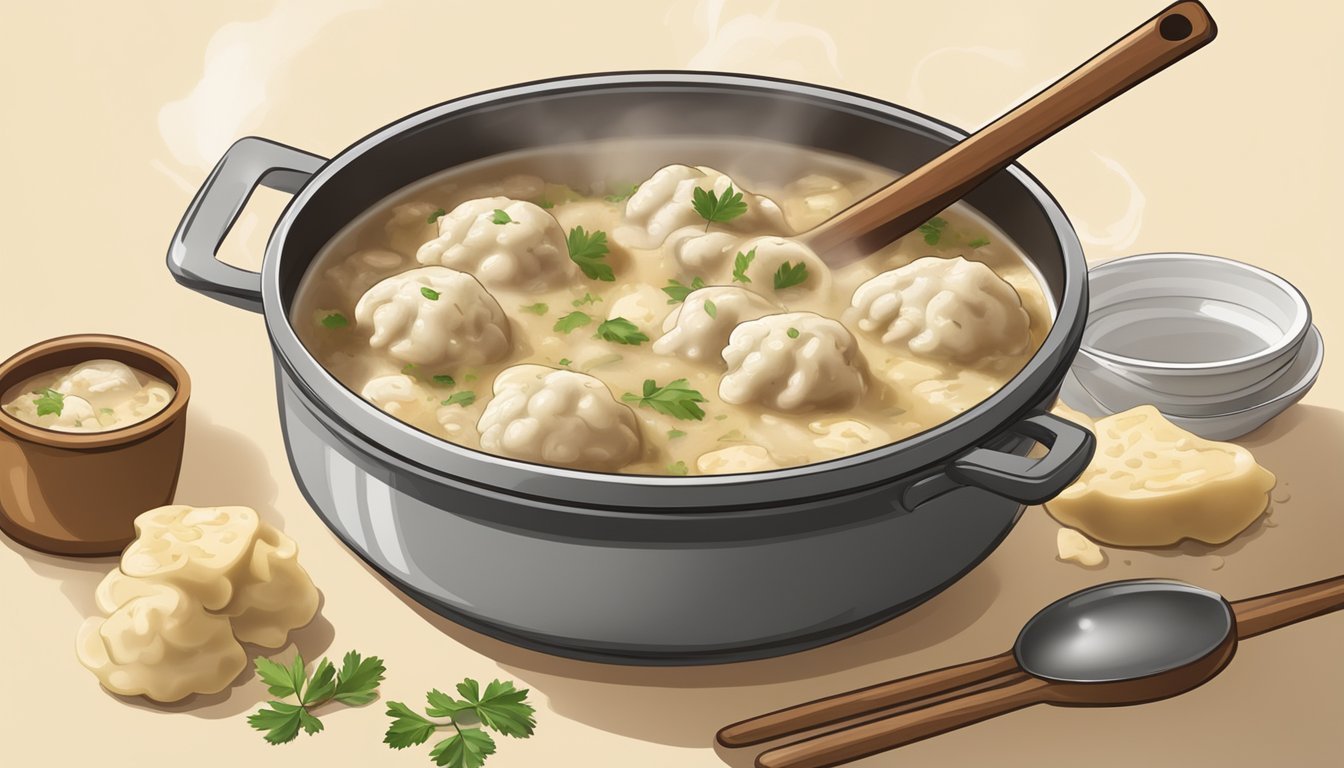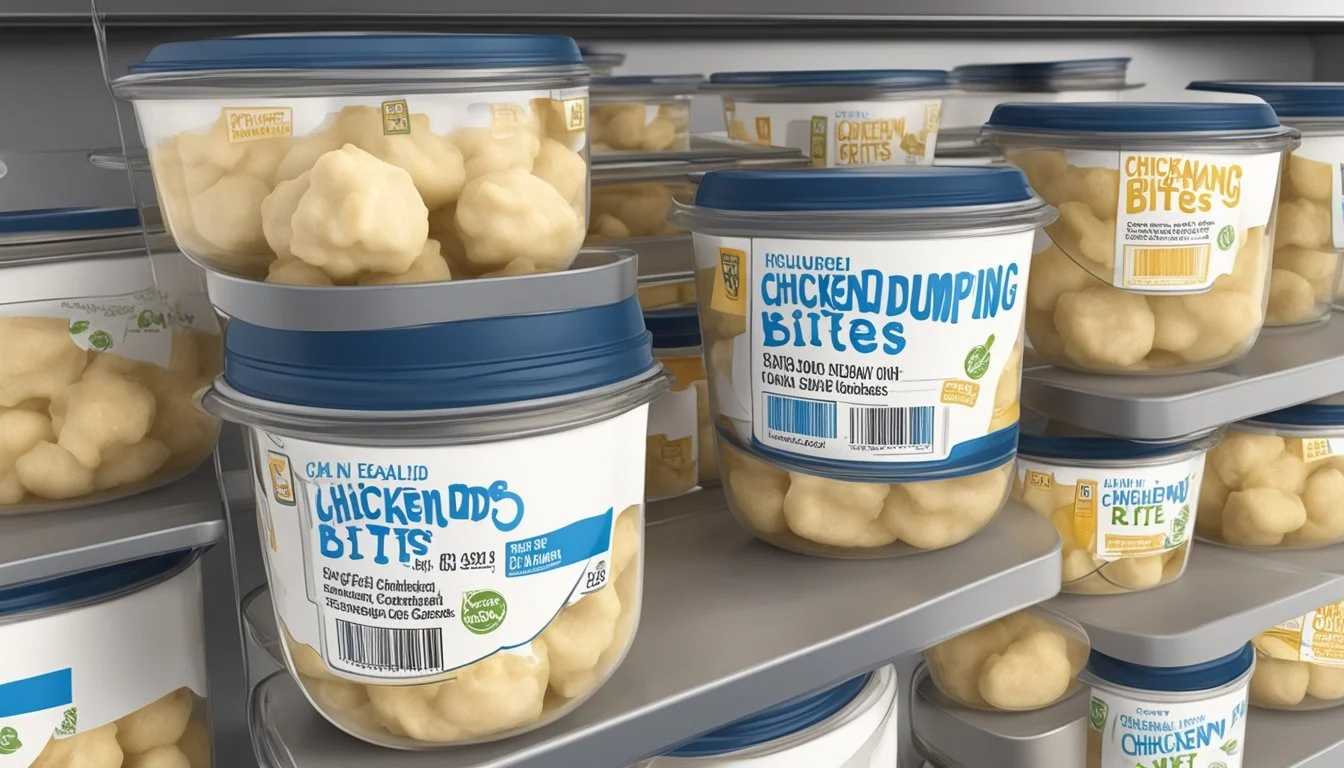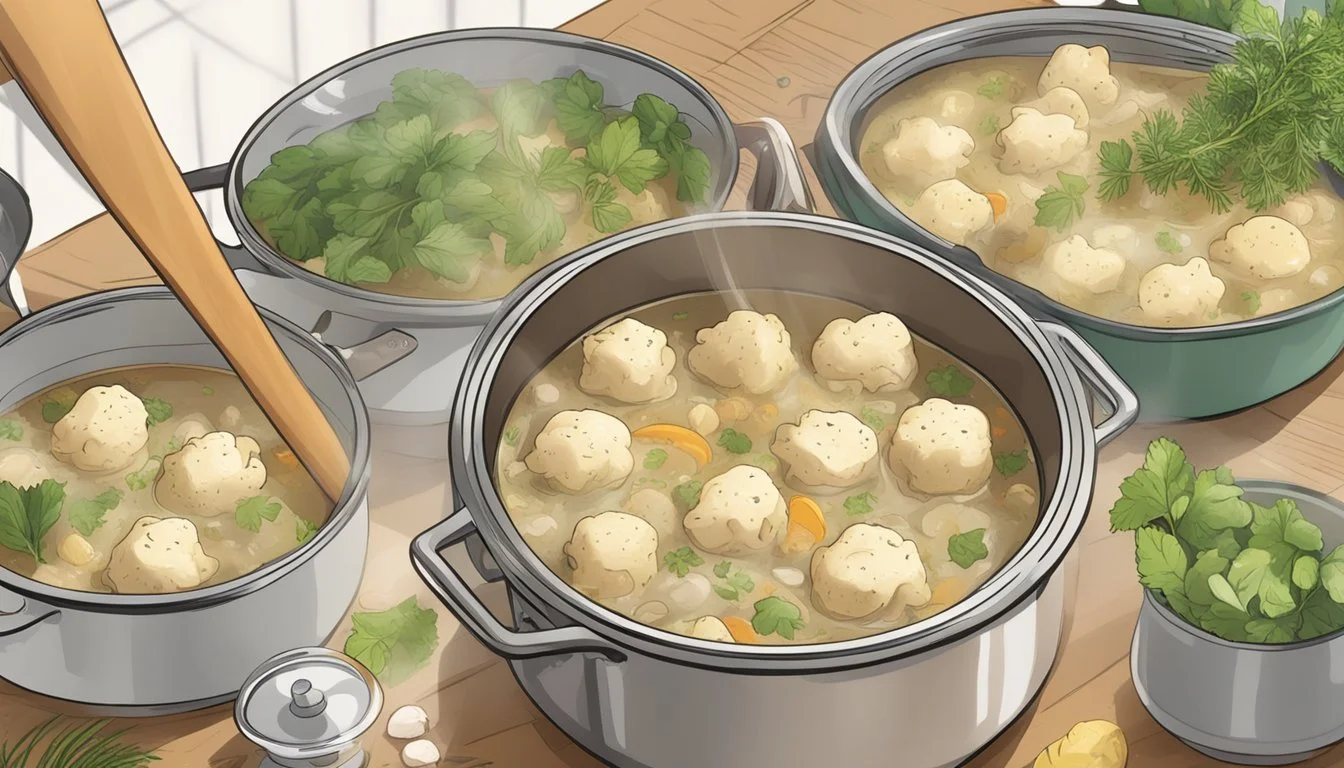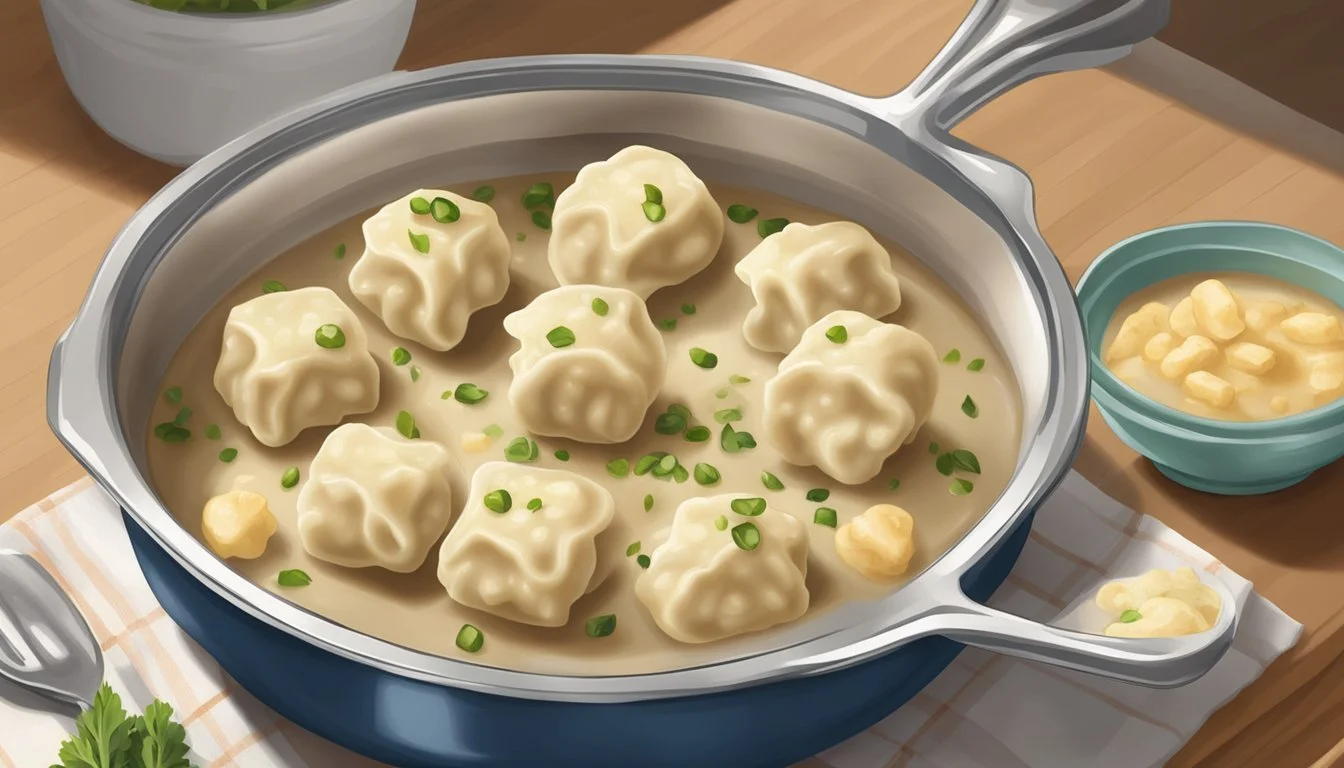How Long Do Chicken and Dumplings Bites Last?
Shelf Life and Storage Tips
Chicken and dumplings offer a comforting, hearty meal perfect for any time of year. There’s often the question of how long leftovers can be safely stored. Cooked chicken and dumplings will last 3-4 days in the refrigerator.
This shelf life ensures that the dish remains both flavorful and safe to eat. The combination of ingredients, including chicken, dumplings, and vegetables, requires careful handling to maintain their quality. Proper storage in an airtight container is paramount to preserve these flavors.
For those who prepare larger batches, freezing chicken and dumplings is an excellent option. This method extends the life of the dish to 2-3 months. Using freezer-safe containers or bags, one can enjoy this traditional comfort food well beyond its initial preparation.
Understanding Chicken and Dumplings
Chicken and dumplings is a hearty dish combining tender chicken, fluffy dumplings, and savory broth with vegetables. Key elements include the ingredients and preparation process, ensuring a flavorful and comforting experience.
Ingredients Breakdown
Chicken and dumplings require a mix of protein, vegetables, and seasonings. Start with chicken, either whole or cut into pieces, providing the primary protein. Common vegetables include onion, carrots, and celery, adding both flavor and nutritional value. For the dumplings, the main ingredients are flour, butter, milk, and baking powder.
Chicken broth serves as the base liquid, with garlic and spices like parsley, salt, and pepper enhancing the flavor. Some recipes incorporate a touch of cream for a richer texture. Combining these ingredients properly is crucial for achieving the desired taste and consistency.
Classic Recipe Overview
To prepare chicken and dumplings, begin by cooking the chicken in a large pot with vegetables and chicken broth. Once the chicken is tender, typically after about 25 minutes, remove and shred it. Meanwhile, sauté the onions, carrots, and celery until tender. Add flour to create a roux, thickening the broth.
Next, incorporate the dumplings by mixing flour, butter, milk, and seasonings to form a dough. Drop spoonfuls of the dough into the simmering broth, allowing them to cook until they are fluffy and fully cooked inside. Finally, return the shredded chicken to the pot, ensuring it's heated through. The resulting dish combines the tender chicken, savory broth, and soft dumplings for a comforting meal.
Proper Storage Techniques
To ensure chicken and dumplings bites last as long as possible, appropriate storage is essential. This guide provides methods for refrigerating freshly made bites, freezing them for extended periods, and choosing the best containers for preserving them without compromising quality.
Refrigerating Freshly Made Bites
Freshly made chicken and dumplings bites should be cooled to room temperature before storing. Place them in an airtight container to maintain their freshness.
In the refrigerator, they can typically last between 3-4 days. Storing them in the fridge helps reduce bacterial growth. Always place the container on a cold shelf, not the door, where temperatures can fluctuate.
A helpful tip is to label the container with the date to ensure they are consumed within a safe timeframe. For the best texture, reheat bites in an oven or on a stovetop rather than a microwave, which can make them soggy.
Freezing for Long-Term Storage
For extended storage, freezing is the optimal option. First, arrange the bites on a baking sheet so they do not touch each other. Freeze them until solid, usually about 2-4 hours. Afterward, transfer the bites into freezer-safe bags or an airtight container.
Ensure all excess air is removed to prevent freezer burn. Properly frozen chicken and dumplings bites can last 2-3 months. Label the bags or containers with the date before placing them in the freezer. When ready to consume, thaw in the fridge overnight for even defrosting.
Best Containers for Preservation
Using the right containers plays a crucial role in maintaining the quality of chicken and dumplings bites. Airtight containers are ideal for refrigeration as they prevent air from getting in, keeping the bites moist. For freezing, freezer bags are preferable as they can be tightly sealed and take up less space.
It's important to select containers that are BPA-free and specifically designed for food storage. Containers with a good seal will help safeguard against freezer burn and keep the bites tasting fresh. Always ensure containers are clean and dry before using to avoid contamination.
Maximizing Shelf-Life
Proper storage techniques and understanding the signs of spoilage can help maximize the shelf-life of chicken and dumplings bites.
Recognizing Signs of Spoilage
Recognizing spoilage is crucial in preventing foodborne illnesses. Chicken and dumplings bites should be stored in airtight containers and refrigerated promptly. Freshness is typically indicated by a pleasant aroma and texture.
An off smell is often the first sign that the food has gone bad. Check for a sour or pungent odor.
Visual cues, such as mold or discoloration, indicate contamination. These signs should prompt immediate disposal.
Bacteria grow rapidly in improperly stored food, leading to potential health risks. Using the expiration date as a guideline, consume within 3-4 days of refrigeration.
Reheating and Serving
Chicken and dumplings can be a comforting leftover meal if reheated properly. There are several methods to ensure the dumplings stay fluffy and the chicken remains tender while avoiding any risk of dryness.
Using the Stove or Oven
For stovetop reheating, start by placing the chicken and dumplings in a pot. Add a small amount of broth or water to prevent dryness. Cover the pot with a lid, leaving it slightly cracked open to release steam. Heat the mixture on low, stirring occasionally to prevent sticking. Simmer for about 10-15 minutes until thoroughly warmed.
When reheating in the oven, preheat to 350°F (175°C). Use an oven-safe dish and add a bit of broth or water. Cover with aluminum foil to retain moisture. Bake for 20-25 minutes, checking occasionally to ensure even heating. The gentle simmer from both methods helps meld flavors while maintaining the dish's texture.
Microwave Reheating Instructions
Using the microwave is a quicker method, but it requires careful attention to avoid uneven heating. Place the chicken and dumplings in a microwave-safe dish. Add a bit of water or broth and cover the dish loosely to allow steam to escape.
Heat on medium power for 3-4 minutes, stirring every minute to ensure even warming. Check the temperature of both the chicken and dumplings to ensure they are heated through. This method is ideal when time is short, but it’s essential to monitor closely to keep the dumplings fluffy and the chicken moist.
Cooking Tips and Variations
Perfecting chicken and dumplings involves achieving the right dough texture, enhancing the dish with vegetables and seasonings, and exploring alternative cooking methods that suit different preferences.
Achieving the Perfect Dough Texture
The key to excellent dumplings lies in the dough's consistency. Using all-purpose flour creates a balanced structure. Combine the flour with a bit of baking powder to get a fluffier texture.
Mix the dry ingredients with cold butter or shortening, then add just enough liquid, usually boiling water or milk, to form a workable dough. Avoid over-mixing to prevent tough dumplings. For rolling, aim for about 1/8 inch thickness before cutting into desired shapes.
Adding Vegetables and Seasonings
Incorporating vegetables like carrots, celery, and onions not only adds flavor but also nutrition. Sauté the vegetables in a bit of oil or butter until tender.
Season the broth with herbs such as thyme, rosemary, and sage for a profound taste. Use salt and pepper judiciously to enhance the overall flavor profile. Adding minced garlic can provide an extra layer of depth.
Alternative Cooking Methods
Stovetop cooking is traditional, but there are other methods to consider. Using a Dutch oven can help maintain a consistent temperature, ensuring the dumplings cook evenly.
For busy cooks, a slow cooker can be ideal. Start with high heat to bring the broth to a boil, then switch to low and add the dough. This method allows for a hands-off approach while still delivering tender dumplings.
In any method, always ensure the dumplings are cooked through yet remain soft and pliable.
Safeguarding Food Quality
To ensure chicken and dumplings bites remain safe and enjoyable, it's critical to maintain proper storage and handling practices and to be aware of potential foodborne illness risks.
Tips to Prevent Foodborne Illness
Proper storage is essential. Refrigerate chicken and dumplings bites within two hours of cooking to prevent bacteria like Salmonella and E. coli from proliferating. Use airtight containers to maintain freshness and inhibit bacterial growth.
Reheat leftovers to an internal temperature of 165°F (74°C) to kill any lingering bacteria. A food thermometer ensures accuracy. Do not leave reheated portions at room temperature for more than two hours as this can become a breeding ground for bacteria.
Label containers with the date of preparation. Consume refrigerated chicken and dumplings within 3-4 days. For longer storage, freeze them, ensuring quality up to 2-3 months. This practice helps mitigate the risk of foodborne illness and maintains the quality of the meal.
By following these steps, one can effectively safeguard the quality and safety of chicken and dumplings bites, preventing foodborne illnesses and ensuring a pleasant dining experience.
Making Chicken and Dumplings From Scratch
Creating chicken and dumplings from scratch involves preparing homemade dumplings and cooking chicken to perfection. This traditional recipe ensures a rich and comforting dish.
Step-by-Step Homemade Instructions
1. Preparing the Chicken: Start by cooking the chicken. Use a Dutch oven or large pot. Add the cooked chicken: Use boneless, skinless chicken breasts for convenience. Season with salt and pepper, then sauté in a little olive oil until fully cooked, reaching an internal temperature of 165°F (75°C). Remove and set aside.
2. Making the Broth: Melt butter in the same pot. Add chopped onions, carrots, and celery. Sauté until onions are translucent. Stir in minced garlic and cook for an additional minute. Add flour and cook, stirring constantly, to form a roux. Gradually pour in chicken stock, stirring until the mixture thickens.
3. Preparing the Dumplings: In a bowl, mix flour, baking powder, and salt. Create a well in the center. Add milk and melted butter gradually, stirring until a dough forms. Avoid overmixing. Use a spoon to drop small portions of dough into the simmering broth. Cover and cook for 15-20 minutes until dumplings are cooked through.
4. Combining Ingredients: Shred or chop the cooked chicken. Add it back to the pot along with any collected juices. Stir in evaporated milk or cream for richness. Simmer for a few minutes: This allows the flavors to meld, and ensures everything is heated through. Serve hot with a garnish of chopped parsley.
By following these steps, the flavorful, traditional chicken and dumplings recipe is achieved, made entirely from scratch.

